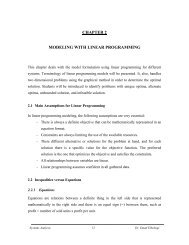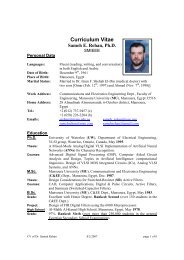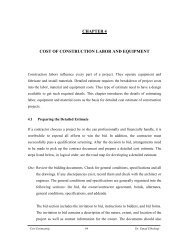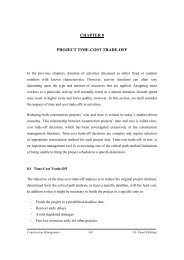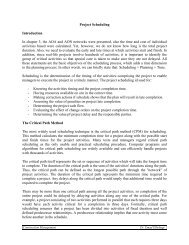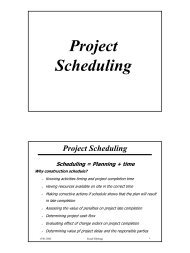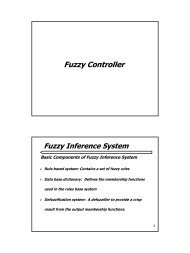Project Time-Cost Trade-Off 7.1 Introduction In the previous chapters ...
Project Time-Cost Trade-Off 7.1 Introduction In the previous chapters ...
Project Time-Cost Trade-Off 7.1 Introduction In the previous chapters ...
You also want an ePaper? Increase the reach of your titles
YUMPU automatically turns print PDFs into web optimized ePapers that Google loves.
determine <strong>the</strong> project-crash cost. Since <strong>the</strong>re are some activities not on <strong>the</strong> critical path that canbe assigned longer duration without delaying <strong>the</strong> project, it is advantageous to change <strong>the</strong> allcrashschedule and <strong>the</strong>reby reduce costs.Heuristic approaches are used to solve <strong>the</strong> time/cost tradeoff problem such as <strong>the</strong> cost-lopemethod used in this chapter. <strong>In</strong> particular, a simple approach is to first apply critical pathscheduling with all activity durations assumed to be at minimum cost. Next, <strong>the</strong> planner canexamine activities on <strong>the</strong> critical path and reduce <strong>the</strong> scheduled duration of activities which have<strong>the</strong> lowest resulting increase in costs. <strong>In</strong> essence, <strong>the</strong> planner develops a list of activities on <strong>the</strong>critical path ranked with <strong>the</strong>ir cost slopes. The heuristic solution proceeds by shorteningactivities in <strong>the</strong> order of <strong>the</strong>ir lowest cost slopes. As <strong>the</strong> duration of activities on <strong>the</strong> shortest pathare shortened, <strong>the</strong> project duration is also reduced. Eventually, ano<strong>the</strong>r path becomes critical, anda new list of activities on <strong>the</strong> critical path must be prepared. Using this way, good but notnecessarily optimal schedules can be identified.The procedure for shortening project duration can be summarized in <strong>the</strong> following steps:1. Draw <strong>the</strong> project network.2. Perform CPM calculations and identify <strong>the</strong> critical path, use normal durations and costsfor all activities.3. Compute <strong>the</strong> cost slope for each activity from <strong>the</strong> following equation:cost slope = crash cost – normal cost / normal duration – crash duration4. Start by shortening <strong>the</strong> activity duration on <strong>the</strong> critical path which has <strong>the</strong> least cost slopeand not been shortened to its crash duration.5. Reduce <strong>the</strong> duration of <strong>the</strong> critical activities with least cost slope until its crash duration isreached or until <strong>the</strong> critical path changes.6. When multiple critical paths are involved, <strong>the</strong> activity(ies) to shorten is determined bycomparing <strong>the</strong> cost slope of <strong>the</strong> activity which lies on all critical paths (if any), with <strong>the</strong>sum of cost slope for a group of activities, each one of <strong>the</strong>m lies on one of <strong>the</strong> criticalpaths.7. Having shortened a critical path, you should adjust activities timings, and floats.8. The cost increase due to activity shortening is calculated as <strong>the</strong> cost slope multiplied by <strong>the</strong>time of time units shortened.9. Continue until no fur<strong>the</strong>r shortening is possible, and <strong>the</strong>n <strong>the</strong> crash point is reached.10. The results may be represented graphically by plotting project completion time againstcumulative cost increase. This is <strong>the</strong> project direct-cost / time relationship. By adding <strong>the</strong>Dr. Emad Elbeltagi



